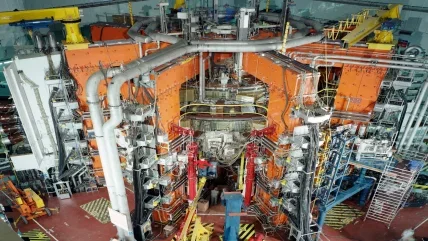
The UK’s Joint European Torus (JET) in Culham near Oxford, which closed at the end of December 2023 after 40 years of operation, “has demonstrated the ability to reliably generate fusion energy, whilst simultaneously setting a world-record in energy output”, according to the UK Atomic Energy Authority (UKAEA).
In JET’s final deuterium-tritium experiments (DTE3), high fusion power was consistently produced for five seconds, resulting in a record of 69 megajoules using just 0.2 milligrams of fuel. These experiments using deuterium and tritium fuel were conducted over seven weeks from August to October, ahead of JET’s closure. “We can reliably create fusion plasmas using the same fuel mixture to be used by commercial fusion energy powerplants, showcasing the advanced expertise developed over time,” said Dr Fernanda Rimini, JET Senior Exploitation Manager.
“This world record is actually a by-product. It was not actively planned, but we were hoping for it,” said Athina Kappatou from the Max Planck Institute in Germany, one of nine Task Force Leaders at JET. “This experimental campaign was mainly about achieving the different conditions necessary for a future power plant and thus testing realistic scenarios. One positive aspect, however, was that the experiments from two years ago could also be successfully reproduced and even surpassed.”
JET was originally a European project built and used collaboratively by European researchers. Since Brexit in 2020, it has been owned, and in recent years has been operated by, the UKAEA. It continued to be used by scientists from 28 European countries to conduct research through work coordinated by the EUROfusion consortium.
Professor Ambrogio Fasoli, Programme Manager (CEO) at EUROfusion, said: “Our successful demonstration of operational scenarios for future fusion machines like ITER and DEMO, validated by the new energy record, instil greater confidence in the development of fusion energy. Beyond setting a new record, we achieved things we’ve never done before and deepened our understanding of fusion physics.”
According to Dr Emmanuel Joffrin, EUROfusion Tokamak Exploitation Task Force Leader at France’s Commissariat à l’Energie Atomique et aux Energies Alternatives (CEA): “Not only did we demonstrate how to soften the intense heat flowing from the plasma to the exhaust, we also showed in JET how we can get the plasma edge into a stable state thus preventing bursts of energy reaching the wall.” He added: “Both techniques are intended to protect the integrity of the walls of future machines. This is the first time that we’ve ever been able to test those scenarios in a deuterium-tritium environment.”
JET’s research will be important for critical implications not only for the International Thermonuclear Experimental Reactor (ITER) under construction in France but also for the UK’s STEP prototype powerplant, Europe’s demonstration powerplant, DEMO, and other global fusion projects.
ITER Director-General Dr Pietro Barabaschi said JET has been “remarkably helpful” as a precursor to ITER. This includes the testing of new materials, the development of innovative new components, “and nowhere more than in the generation of scientific data from Deuterium-Tritium fusion”. He added: “The results obtained here will directly and positively impact ITER, validating the way forward and enabling us to progress faster toward our performance goals. On a personal note, it has been for me a great privilege having myself been at JET for a few years. There I had the opportunity to learn from many exceptional people.”
UK Minister for Nuclear & Networks, Andrew Bowie, said JET’s final fusion experiment “is a fitting swansong after all the groundbreaking work that has gone into the project since 1983”. He noted that the work does not stop with the closure of JET. “Our Fusion Futures programme has committed £650m ($830m) to invest in research and facilities, cementing the UK’s position as a global fusion hub.”
Professor Sir Ian Chapman, UKAEA CEO, said: “JET has operated as close to powerplant conditions as is possible with today’s facilities, and its legacy will be pervasive in all future powerplants. It has a critical role in bringing us closer to a safe and sustainable future.”






